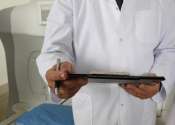Last update:
Radiology & Imaging news
Team captures first-ever 'twitch' of the eye's night-vision cells as they detect light
For the first time, an international research team led by Nanyang Technological University, Singapore (NTU Singapore) has recorded a tiny mechanical "twitch" in living human and rodent eyes at the exact moment a rod photoreceptor ...
Jan 7, 2026
0
31

Seeing thyroid cancer in a new light: When AI meets label-free imaging in the operating room
Thyroid cancer is the most common endocrine cancer, affecting more people each year as detection rates continue to rise. During tumor excision, surgeons often struggle to determine exactly how much tissue should be removed, ...
Jan 6, 2026
0
45

AI gives a clearer picture of functional MRI brain data
Obtaining clearer functional MRI data about the brain and its disorders is possible using artificial intelligence, according to Boston College researchers who report in Nature Methods that they have developed an AI-assisted ...
Jan 6, 2026
0
8

Study highlights effect of Alzheimer's, frontotemporal dementia on subcortical brain structures
A recent study by the Laboratory for Neuro-Analysis and Imaging (LANAI) at UMass Chan Medical School highlights how subcortical brain structures degenerate in Alzheimer's disease and frontotemporal dementia patients.
Jan 6, 2026
0
0

AI detects stomach cancer risk in remote communities from upper endoscopic images
In many regions, doctors practice in settings with limited medical resources. Advanced tests, specialist support, and expert guidance for complex decisions are often unavailable. Under these circumstances, accurate automated ...
Jan 2, 2026
0
0

Mammograms may reveal hidden heart risks for women, study finds
Routine mammograms are best known as a front-line tool for detecting breast cancer. But new research suggests the same X-ray images may also offer an early warning sign for cardiovascular disease—the leading cause of death ...
Dec 29, 2025
0
1

Study finds a better way to screen for breast cancer
A pioneering study has found that an individualized approach to breast cancer screening that assesses patients' risk, rather than annual mammograms, can lower the chance of more advanced cancers, while still safely match ...
Dec 26, 2025
0
41

Automatic label checking: The missing step in making medical AI reliable
Researchers at Osaka Metropolitan University have discovered a practical way to detect and fix common labeling errors in large radiographic collections. By automatically verifying body-part, projection, and rotation tags, ...
Dec 24, 2025
0
0

Signature neural patterns may help predict recovery from traumatic brain injury
After traumatic brain injury (TBI), some patients may recover completely, while others retain severe disabilities. Accurately evaluating prognosis is challenging in patients on life-sustaining therapy.
Dec 23, 2025
0
49

30-year smoking duration-based criteria could increase lung cancer screening
Thirty-year smoking duration-based criteria could reduce eligibility gaps for all races relative to whites, while improving six-year lung cancer detection sensitivity, according to a study published online Dec. 16 in the ...
Dec 19, 2025
0
0

New Raman imaging system detects subtle tumor signals
Researchers have developed a new compact Raman imaging system that is sensitive enough to differentiate between tumor and normal tissue. The system offers a promising route to earlier cancer detection and to making molecular ...
Dec 18, 2025
0
10

WISDOM trial weighs risk-based cancer screening
University of California, San Francisco investigators led WISDOM, a randomized comparison of risk-based breast cancer screening and annual mammography. Rates of stage ≥IIB breast cancers met a noninferiority threshold under ...

Brain on jazz: Musical improvisation moves beyond pure inspiration to dynamic reconfiguration
An international research team investigated the brains of 16 jazz pianists while they played a piece from memory, improvised based on the melody, and freely improvised based on the chord changes. The analysis of how different ...
Dec 17, 2025
0
64

AI can detect early signs of aging from chest X-rays
Artificial intelligence may be able to reveal how fast your body is aging by analyzing a chest X-ray, according to a new study published in The Journals of Gerontology, Series A: Biological Sciences and Medical Sciences. ...
Dec 17, 2025
0
0

New technology reduces false positives in breast ultrasounds
New ultrasound technology developed at Johns Hopkins can distinguish fluid from solid breast masses with near perfect accuracy, an advance that could save patients, especially those with dense breast tissue, from unnecessary ...
Dec 17, 2025
0
0

40% of MRI signals do not correspond to actual brain activity, study suggests
For almost three decades, functional magnetic resonance imaging (fMRI) has been one of the main tools in brain research. Yet a new study published in Nature Neuroscience fundamentally challenges the way fMRI data have so ...
Dec 16, 2025
1
225

Bioluminescent tool captures neural activity without external lasers
A decade ago, a group of scientists had the literally brilliant idea to use bioluminescent light to visualize brain activity.
Dec 12, 2025
0
94

Fat tissue around the heart may contribute to greater heart injury after a heart attack
Increased volume of epicardial adipose tissue, detected by cardiovascular imaging, was found to be associated with greater myocardial injury after a myocardial infarction. These findings were presented at EACVI 2025, the ...
Dec 12, 2025
0
0

Imaging study solves a long-standing gap in metastatic breast cancer research and care
A prospective, multicenter cancer clinical trial by the ECOG-ACRIN Cancer Research Group (ECOG-ACRIN) has validated an improved method for predicting treatment benefits in patients with hormone receptor-positive (HR+) metastatic ...
Dec 11, 2025
0
0

Daily scans during prostate cancer could guide changes to treatment, reduce the risk of side effects, study suggests
Daily scans taken during prostate cancer radiotherapy could be repurposed to guide changes to treatment, reducing the risk of side effects, a study suggests.
Dec 11, 2025
0
1

Calcium in breast arteries predicts future cardiovascular disease
Routine mammograms are a critical tool for breast cancer screening. However, they may also hold crucial, potentially untapped information about a person's risk for cardiovascular disease, the number one cause of death among ...
Dec 11, 2025
0
0

Breast MRI may be safely omitted from diagnostic workup in certain patients with early-stage, HR-negative breast cancer
Patients with stage 1 or 2, hormone receptor (HR)-negative breast cancer had similar five-year rates of locoregional recurrence whether or not they underwent preoperative breast magnetic resonance imaging (MRI) in addition ...
Dec 11, 2025
0
0

Clinicians now have powerful new tools to diagnose multiple sclerosis earlier
The faster patients can be diagnosed with multiple sclerosis, the sooner they can begin taking the powerful medications that can prevent further brain damage.
Dec 11, 2025
0
0













































